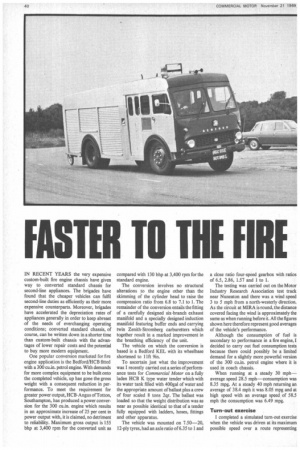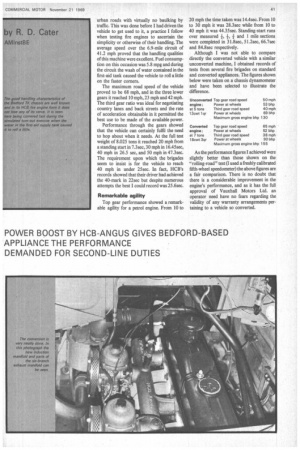FASTER TO THE FIRE
Page 42

Page 43

If you've noticed an error in this article please click here to report it so we can fix it.
IN RECENT YEARS the very expensive custom-built fire engine chassis have given way to converted standard chassis for second-line appliances. The brigades have found that the cheaper vehicles can fulfil second-line duties as efficiently as their more expensive counterparts. Moreover, brigades have accelerated the depreciation rates of appliances generally in order to keep abreast of the needs of everchanging operating conditions; converted standard chassis, of course, can be written down in a shorter time than custom-built chassis with the advantages of lower repair costs and the potential to buy more modern equipment.
One popular conversion marketed for fire engine application is the Bedford/HCB fitted with a 300 cu.in. petrol engine. With demands for more complex equipment to be built onto the completed vehicle, up has gone the gross weight with a consequent reduction in performance. To meet the requirement for greater power output, HCB-Angus of Totton, Southampton, has produced a power conversion for the 300 cu.in. engine which results in an approximate increase of 25 per cent in power output with, it is claimed, no detriment to reliability. Maximum gross output is 155 bhp at 3,400 rpm for the converted unit as compared with 130 bhp at 3,400 rpm for the standard engine.
The conversion involves no structural alterations to the engine other than the skimming of the cylinder head to raise the compression ratio from 6.8 to 7.1 to I_ The remainder of the conversion entails the fitting of a carefully designed six-branch exhaust manifold and a specially designed induction manifold featuring buffer ends and carrying twin Zenith-Stromberg carburetters which together result in a marked improvement in the breathing efficiency of the unit.
The vehicle on which the conversion is based is a Bedford KEL with its wheelbase shortened to 11ft 9in.
To ascertain just what the improvement was I recently carried out a series of performance tests for Commercial Motor on a fully laden HCB K type water tender which with its water tank filled with 400gal of water and the appropriate amount of ballast plus a crew of four scaled 8 tons 2qr. The ballast was loaded so that the weight distribution was as near as possible identical to that of a tender fully equipped with ladders, hoses, fittings and other apparatus.
The vehicle was mounted on 7.50-20, 12-ply tyres, had an axle ratio of 6.35 to 1 and a close ratio four-speed gearbox with ratios of 6.5, 2.86, 1.57 and 1 to 1.
The testing was carried out on the Motor Industry Research Association test track near Nuneaton and there was a wind speed 3 to 5 mph from a north-westerly direction. As the circuit at MIRA is round, the distance covered facing the wind is approximately the same as when running before it. All the figures shown here therefore represent good averages of the vehicle's performance.
Although the consumption of fuel is secondary to performance in a fire engine, I decided to carry out fuel consumption tests because there could possibly be a limited demand for a slightly more powerful version of the 300 cu.in. petrol engine where it is used in coach chassis.
When running at a steady 30 mph— average speed 28.5 mph—consumption was 8.35 mpg. At a steady 40 mph returning an average of 38.4 mph it was 8.05 mpg and at high speed with an average speed of 58.5 mph the consumption was 6.49 mpg.
Turn-out exercise I completed a simulated turn-out exercise when the vehicle was driven at its maximum possible speed over a route representing urban roads with virtually no baulking by traffic. This was done before I had driven the vehicle to get used to it, a practice I follow when testing fire engines to ascertain the simplicity or otherwise of their handling. The average speed over the 6.9-mile circuit of 41.2 mph proved that the handling qualities of this machine were excellent. Fuel consumption on this occasion was 5.8 mpg and during the circuit the wash of water contained in the first-aid tank caused the vehicle to roll a little on the faster corners.
The maximum road speed of the vehicle proved to be 68 mph, and in the three lower gears it reached 10 mph, 23 mph and 42 mph. The third gear ratio was ideal for negotiating country lanes and back streets and the rate of acceleration obtainable in it permitted the best use to be made of the available power.
Performance through the gears showed that the vehicle can certainly fulfil the need to hop about when it needs. At the full test weight of 8.025 tons it reached 20 mph from a standing start in 7.3sec, 30 mph in 16.45sec, 40 mph in 26.5 sec, and 50 mph in 47.3sec. The requirement upon which the brigades seem to insist is for the vehicle to reach 40 mph in under 25sec. In fact, HCB's records showed that their driver had achieved the 40-mark in 22sec but despite numerous attempts the best I could record was 25.6sec.
Remarkable agility Top gear performance showed a remarkable agility for a petrol engine. From 10 to 20 mph the time taken was 14.4sec. From 10 to 30 mph it was 28.3sec while from 10 to 40 mph it was 44.35sec. Standing-start runs
over measured +, +, and 1 mile sections were completed in 31.8sec, 51.2sec, 66.7sec and 84.8sec respectively.
Although I was not able to compare directly the converted vehicle with a similar unconverted machine, I obtained records of tests from several fire brigades on standard and converted appliances. The figures shown below were taken on a chassis dynamometer and have been selected to illustrate the difference.
Unconverted Top gear road speed 50 mph ongine ; Power at wheels 53 bhp at 5 tons Third gear road speed 40 mph 1 3cwt lqr Power at wheels 69 bhp Maximum gross engine bhp 130 Converted Top gear road speed 65 mph engine: Power at wheels 52 bhp at 7 tons Third gear road speed 38 mph 18cwt 3qr Power at wheels 90 bhp Maximum gross engine bhp 155
As the performance figures I achieved were slightly better than those shown on the "rolling-road" test (I used a freshly calibrated fifth-wheel speedometer) the above figures are a fair comparison. There is no doubt that there is a considerable improvement in the engine's performance, and as it has the full approval of Vauxhall Motors Ltd. an operator need have no fears regarding the validity of any warranty arrangements pertaining to a vehicle so converted.




































































































